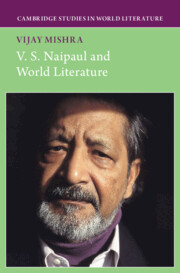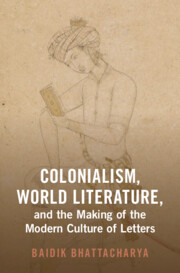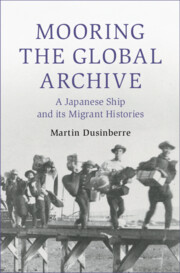178 results
2 - Colonialism and Modern Sexuality
-
-
- Book:
- The Cambridge World History of Sexualities
- Published online:
- 26 April 2024
- Print publication:
- 16 May 2024, pp 27-49
-
- Chapter
- Export citation
Recovering the Dalit Public Sphere: Vernacular Liberalism in Late Colonial North India
-
- Journal:
- Comparative Studies in Society and History , First View
- Published online by Cambridge University Press:
- 01 April 2024, pp. 1-26
-
- Article
-
- You have access
- Open access
- HTML
- Export citation
Mathematics, Mao, and Many Reasons. An Interview with Kapil Raj
-
- Journal:
- Itinerario / Volume 48 / Issue 1 / April 2024
- Published online by Cambridge University Press:
- 10 May 2024, pp. 1-9
- Print publication:
- April 2024
-
- Article
- Export citation
The Isfahan Anthology Project
-
- Journal:
- Iranian Studies / Volume 57 / Issue 2 / April 2024
- Published online by Cambridge University Press:
- 04 March 2024, pp. 295-302
- Print publication:
- April 2024
-
- Article
-
- You have access
- Open access
- HTML
- Export citation
Chapter 12 - Non-linear Methodologies for Researching Early Modern Performance:
- from Part III - Interpreting
-
-
- Book:
- The Cambridge Guide to Mixed Methods Research for Theatre and Performance Studies
- Published online:
- 01 February 2024
- Print publication:
- 08 February 2024, pp 236-254
-
- Chapter
- Export citation
Chapter 5 - In the Shadow of the Master
-
- Book:
- V. S. Naipaul and World Literature
- Published online:
- 01 February 2024
- Print publication:
- 08 February 2024, pp 131-163
-
- Chapter
- Export citation

V. S. Naipaul and World Literature
-
- Published online:
- 01 February 2024
- Print publication:
- 08 February 2024

Colonialism, World Literature, and the Making of the Modern Culture of Letters
-
- Published online:
- 19 January 2024
- Print publication:
- 08 February 2024
1 - Introduction
-
- Book:
- The Metamorphosis of the Amazon
- Published online:
- 13 December 2023
- Print publication:
- 21 December 2023, pp 1-26
-
- Chapter
- Export citation
Introduction
-
- Book:
- Mandatory Madness
- Published online:
- 16 November 2023
- Print publication:
- 30 November 2023, pp 1-32
-
- Chapter
- Export citation
Censoring Our History
-
- Journal:
- Transactions of the Royal Historical Society , First View
- Published online by Cambridge University Press:
- 08 November 2023, pp. 1-11
-
- Article
-
- You have access
- Open access
- HTML
- Export citation
Introduction
-
- Book:
- Working-Class Raj
- Published online:
- 20 October 2023
- Print publication:
- 02 November 2023, pp 1-23
-
- Chapter
- Export citation
History by Commission? The Belgian Colonial Past and the Limits of History in the Public Eye
-
- Journal:
- The Journal of African History / Volume 64 / Issue 3 / November 2023
- Published online by Cambridge University Press:
- 21 December 2023, pp. 334-343
- Print publication:
- November 2023
-
- Article
-
- You have access
- Open access
- HTML
- Export citation
African Intellectuals and Abolitionists - Lourenço da Silva Mendonça and the Black Atlantic Abolitionist Movement in the Seventeenth Century By José Lingna Nafafé. Cambridge: Cambridge University Press, 2022. Pp. 468. $59.99, hardcover (ISBN: 9781108838238); $59.99, ebook (ISBN: 9781108974196).
-
- Journal:
- The Journal of African History / Volume 64 / Issue 3 / November 2023
- Published online by Cambridge University Press:
- 22 January 2024, pp. 457-458
- Print publication:
- November 2023
-
- Article
- Export citation
Property, Power, and Imperialism in Angola - Wealth, Land, and Property in Angola: A History of Dispossession, Slavery, and Inequality By Mariana P. Candido. Cambridge: Cambridge University Press, 2022. Pp. 288. $110.00, hardcover (ISBN: 9781316511503); $34.99, paperback (ISBN: 9781009055987); $26.00, ebook (ISBN: 9781009052986).
-
- Journal:
- The Journal of African History / Volume 64 / Issue 3 / November 2023
- Published online by Cambridge University Press:
- 09 January 2024, pp. 455-456
- Print publication:
- November 2023
-
- Article
- Export citation

Mooring the Global Archive
- A Japanese Ship and its Migrant Histories
-
- Published online:
- 19 October 2023
- Print publication:
- 05 October 2023
-
- Book
-
- You have access
- Open access
- Export citation
Conclusion
- from Part III - Inventing Settler Science
-
- Book:
- The Antipodean Laboratory
- Published online:
- 21 September 2023
- Print publication:
- 05 October 2023, pp 247-259
-
- Chapter
- Export citation
Was There an Administrative Revolution?
-
- Journal:
- Journal of Chinese History / Volume 8 / Issue 1 / January 2024
- Published online by Cambridge University Press:
- 31 August 2023, pp. 147-166
-
- Article
-
- You have access
- Open access
- HTML
- Export citation
Chapter 13 - Comics and Their Archives
- from Part III - Uses
-
-
- Book:
- The Cambridge Companion to Comics
- Published online:
- 17 August 2023
- Print publication:
- 31 August 2023, pp 267-286
-
- Chapter
- Export citation
Unravelling Britishness
-
- Journal:
- Transactions of the Royal Historical Society / Volume 1 / December 2023
- Published online by Cambridge University Press:
- 25 August 2023, pp. 363-368
- Print publication:
- December 2023
-
- Article
-
- You have access
- Open access
- HTML
- Export citation



